Ihr Warenkorb ist derzeit leer!
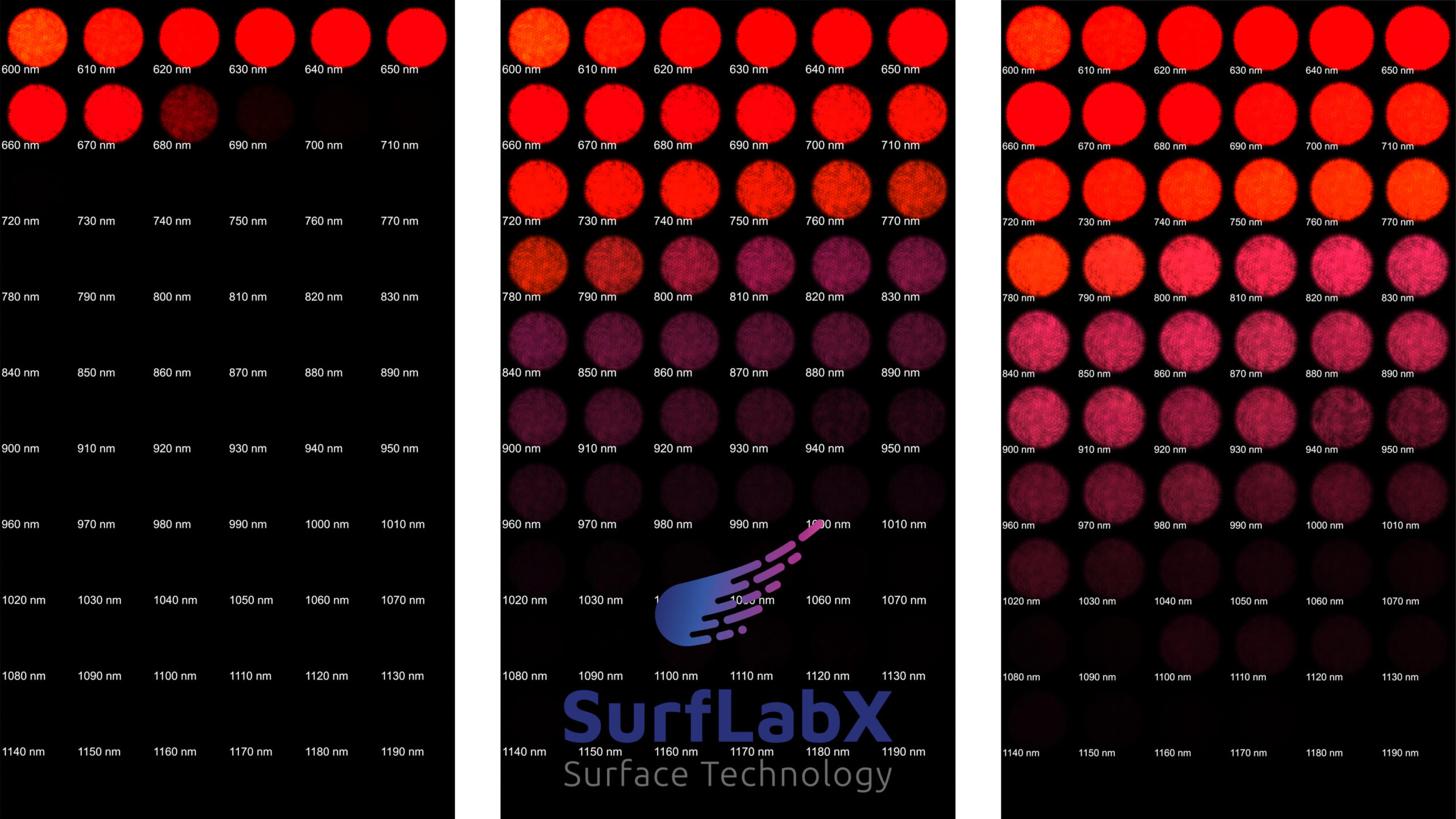
Limit of Infrared sensitivity for different camera sensors
Welche Kamera ist eigentlich die Beste für Infrarot? Ist das Modell X besser für IR geeignet ist als Modell Y? Durch langjährige Erfahrung lautetete die Antwort immer: “Es macht eigentlich keinen großen Unterschied”. Diese Bauchgefühl ist für die kreative IR Fotografie mehr als ausreichend und damit könnte der Artikel schon zu Ende sein. Aber für bestimmte Anwendungen, insbesondere für Electroluminescence measurements of photovoltaic modules, the actual sensitivity at the limit of the camera sensors may be quite important. This long-held assumption can now be supported by a few solid measurements of various CMOS sensors. The company SurfLabX from Taufkirchen (Germany) has measured various Fullspectrum modified cameras from IRreCams in their laboratory and we can take a closer look at the results.
A short Summary
A brief summary for those of us in a hurry: All Fullspectrum cameras tested were able to detect Infrared light in the range of 1,000 nm to 1,200 nm. It made no significant difference whether a Fullframe, APS-C or MicroFourThirds sensor was installed, nor did the manufacturer of the sensors (Canon, Panasonic, Sony) appear to have any significant influence on the result. Likewise, a modern Backside Iluminated sensor (BSI) shows no fundamental advantage over regular Frontside Iluminated sensors.
Above 1,200 nm, virtually no sensitivity could be measured with the cameras; this is probably the technical limit of the semiconductor material (silicon). The bottom line is that similarly good results can be achieved in the near Infrared with all cameras and sensors from the last few years.
The crucial factors for image quality are rather the noise performance and the dynamic range of the camera (these key figures are available in the visible range through various tests). Things like ergonomics, autofocus speed and available lenses should be much more the deciding criteria when it comes to the question of which camera is the best for Infrared. Because this question is, as in the visible spectrum, highly subjective.
Experimental setup and qualitative evaluation
And now for the long version, let's first take a look at how the cameras were tested. A monochromator was used to send a monochromatic light beam directly onto the sensor of the cameras. No lens was mounted on the cameras, so the radiation could hit the camera sensor without obstruction. The images were then captured at ISO 200 with an exposure time of 1/30 s each in RAW format for further processing. Here is a collage of the individual images without additional processing.
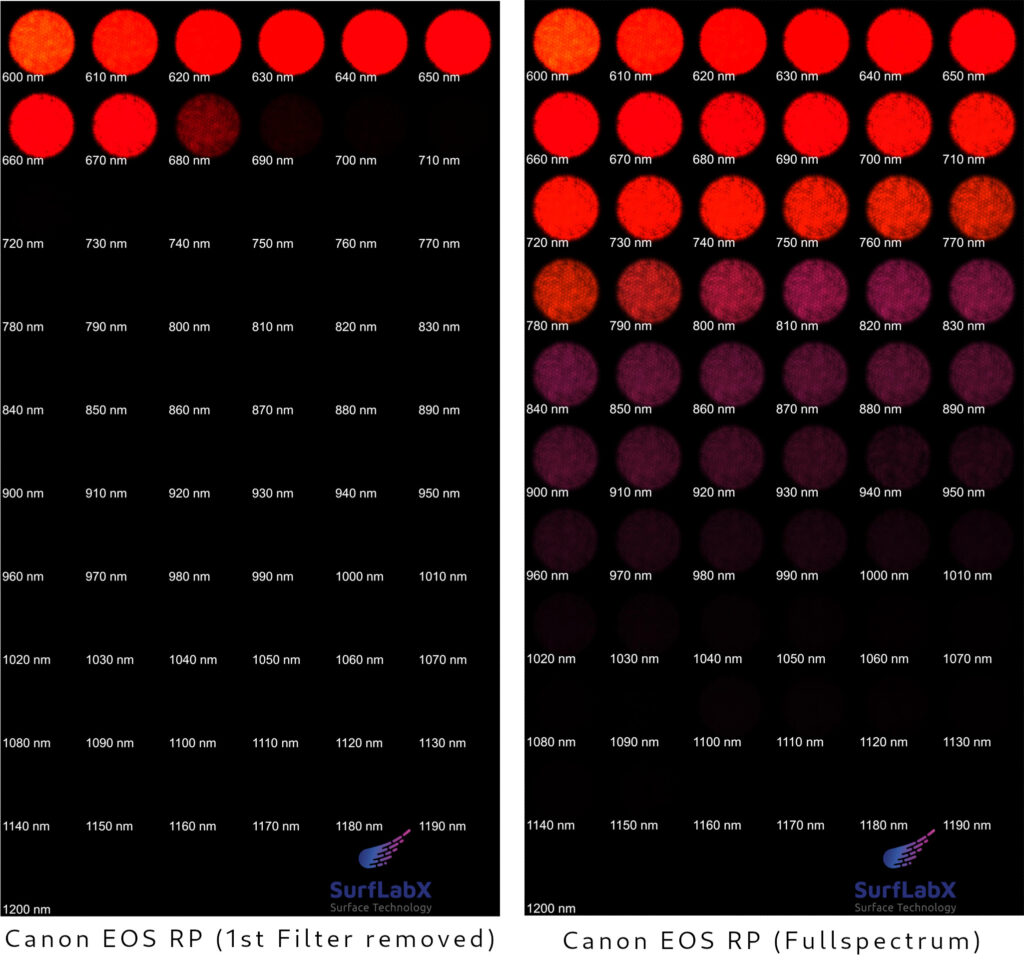
On the left is a Canon EOS RP with only the first blocking filter removed (the camera corresponds roughly to an Astro conversion), on the right is a Fullspectrum Canon EOS RP. With the naked eye you can already see that the Infrared radiation above 700 nm can only generate a signal on the sensor after a Fullspectrum conversion. However, very little can be seen in the darker fields without processing. In order to improve the visibility for the eye, the brightness of all individual images was adjusted to a uniform level.

This image shows the unprocessed version of the Fullspectrum RP on the left and the brightened images of the same file on the right. As was to be expected, there is significantly more information in the dark areas of the RAW files than the unprocessed images would suggest. At the same time, however, the noise is also brightened and increased with the processing. In the last 3 images, you can see how the actual signal is increasingly lost in the noise and threatens to disappear.
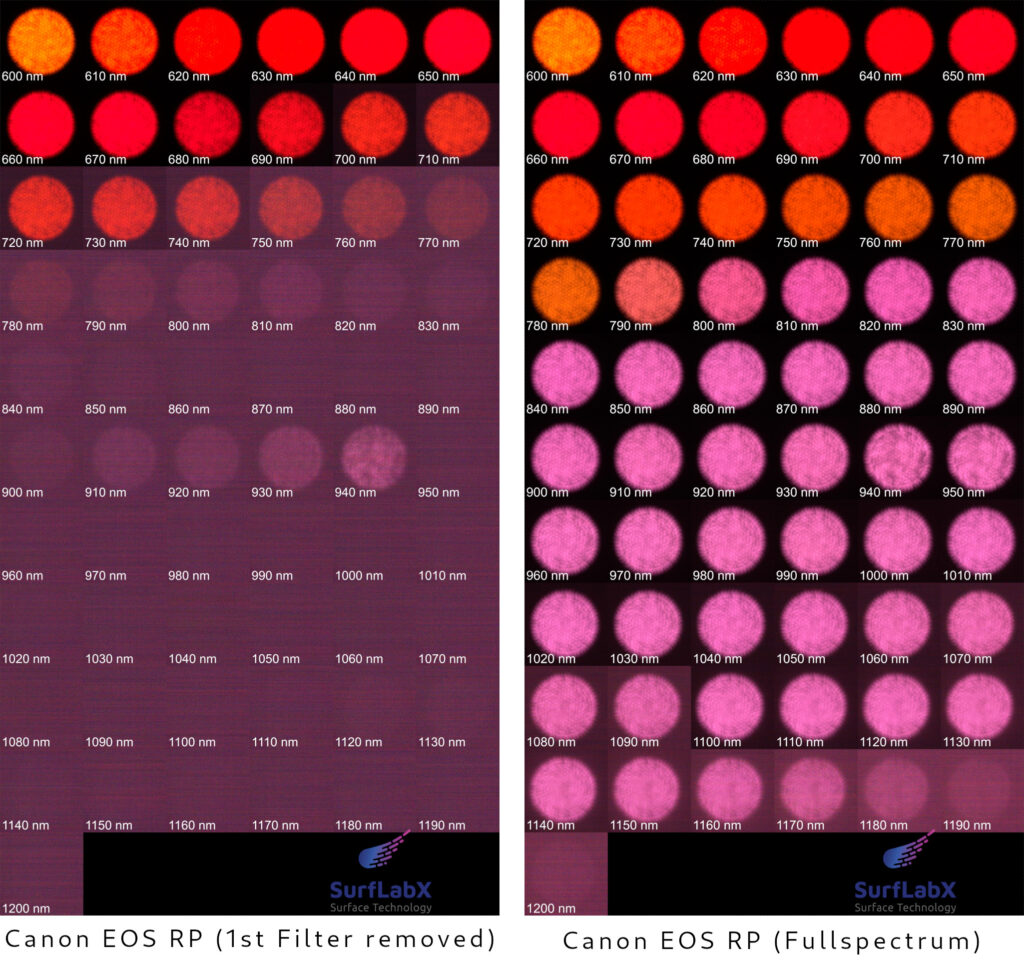
Wenn wir nun die Canon EOS RP ohne den ersten Sperrfilter noch einmal mit der Vollspektrum RP vergleichen, ist sehr deutlich erkennbar, dass ohne eine Vollspektrum Modifikation praktisch nur noch Rauschen hindurch kommt. Für Infrarot Licht ist solch eine Kamera, bzw. eine nicht modifizierte Kamera absolut unbrauchbar. Ab und an sind noch einmal kleinere Signale zu erkennen (z.B. bei 910 – 940 nm), diese kommen aller Wahrscheinlichkeit daher, dass der noch verbaute Sperrfilter kleine “Lecks” im IR hat (kleine Schwankungen im Transmissionsverlauf sind durchaus normal bei Interferenzfiltern) .
Before we look at all the results, here is a comparison of an APS-C camera with a Fullframe camera:

Beide Kameras wurden auf Vollspektrum umgebaut und bei beiden Kameras handelt es sich um “moderne” BSI Sensoren. Rein qualitativ betrachtet ist aber kein großer Unterschied zwischen der Fujifilm X-T3 und der Sony A7R III zu erkennen. Aktuelle Sensorgenerationen haben, unabhängig von ihrer Größe, seid ein paar Jahren ein Leistungsplateau erreicht bei dem sie quasi gleichauf sind.
Results in detail
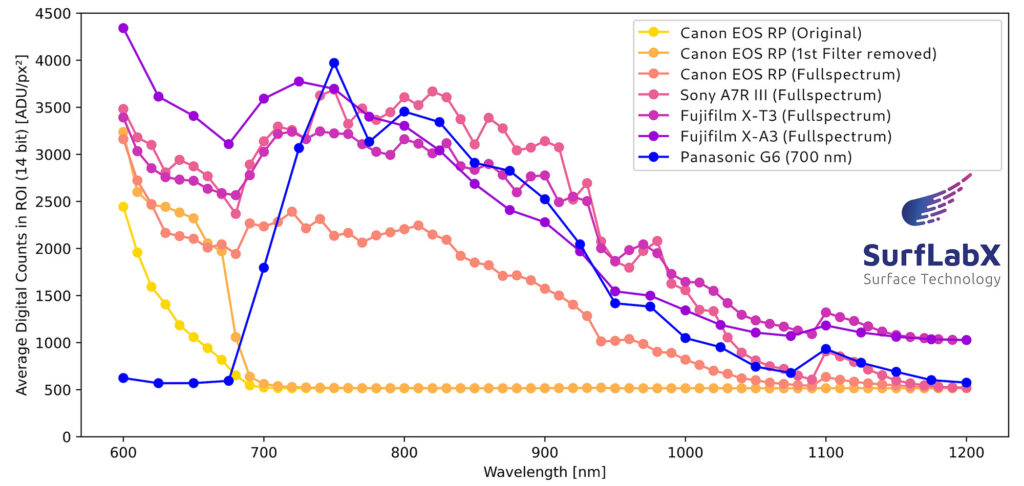
The graph above summarizes all test results and shows the signal strength as a function of the measured wavelength. The higher the value at a wavelength, the more sensitive the sensor is. The unmodified Canon EOS RP and the RP without the first blocking filter clearly show no sensitivity for Infrared radiation above 700 nm, they are at the very bottom of the diagram. Only with an Infrared conversion the radiation can reach the sensor without restriction and be detected there. All Fullspectrum cameras show more or less the same characteristics and are very close to each other. The Panasonic G6 tested had a 700 nm long-pass filter installed; here the curve matches the other Fullspectrum cameras from approx. 750 nm.
I would like to address one apparent outlier right away: The Fullspectrum Canon EOS RP seems to deliver visibly worse results than all other cameras tested. After some research, it turned out that the test parameters for this camera were chosen in an unfavorable way. For some reason, the readout noise of the RP in the low ISO ranges (the measurements were taken at ISO 200) is significantly higher than with other cameras (by a factor of 3). From an ISO range of 3,200, however, the noise of the RP approaches that of the other cameras and is then at eye level. If the measurements had all been taken at a higher ISO, the RP would almost certainly not be out of line with the other results.
Now that we are talking about noise, we also need to look at the noise characteristics of the individual sensors in order to better understand the curves in the diagram above. If a camera was extremely noisy, in the end we would only have measured the noise and not the true signal that the sensor delivers to us. The noise characteristics of the cameras must therefore also be taken into account when making an assessment.
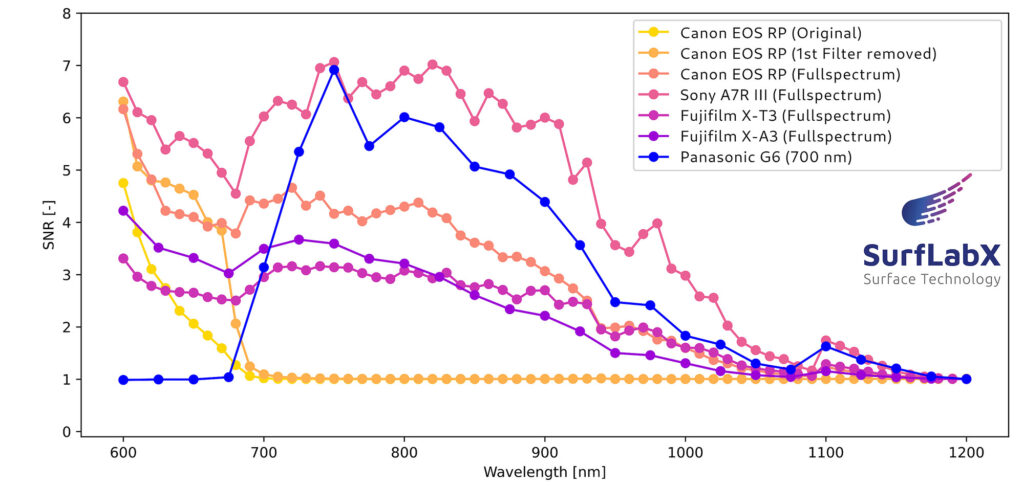
Diese Grafik zeigt das Rauchverhalten (SNR) in Abhängikgiet von der gemessenen Wellenlänge. Ein höherer Wert bedeutet, dass die Kamera ein “saubereres” Signal liefert und weniger Rauschen in der Aufnahme enthalten ist. Wieder sind alle Kameras mehr oder weniger eng beieinander und zeigen ein ähnliches Bild. Ab 800 nm Wellenlänge werden die Ergebnisse zunehmend schlechter und gehen um 1.200 nm gegen eine Grenze – hier ist nur noch Rauschen zu beobachten.
A comparison between the Fujifilm X-A3 (frontside illuminated sensor) and the X-T3 (backside illuminated sensor) shows no significant difference in signal behavior or noise characteristics. This type of sensor production therefore does not appear to have any significant influence on IR sensitivity.
If you look at both diagrams, you can see that at least in the range that is interesting for the electroluminescence of PV modules (950-1,150 nm), all cameras are very close to each other. It is difficult to recognize a difference and to make a recommendation in one direction or the other.
Aber versuchen wir doch ruhig einmal einen Sieger zu küren. Wenn wir beide Diagramme betrachten schneidet die Sony A7R III sowohl im Signalverhalten als auch beim Rauschen mit am besten ab. Wenn wir eine “schlechteste” Kamera küren wollen, muss es anhand der vorliegenden Daten wohl die Canon EOS RP werden. Ich möchte noch einmal betonen, dass dies nur durch die Kombination der Messparameter in Kombination mit der internen Signalverarbeitung der Kamera so ist – bei höheren ISO Werten würde die RP ziemlich sicher auch auf Augenhöhe mit den anderen Kameras liegen (gerade für die Elektrolumineszenz Messung von Photovoltaik Modulen kommen hohe ISO Werte zum Einsatz).
Was bedeutet das nun aber in der Praxis, wenn wir uns den “Gewinner” und “Verlierer” einmal nebeneinander ansehen?
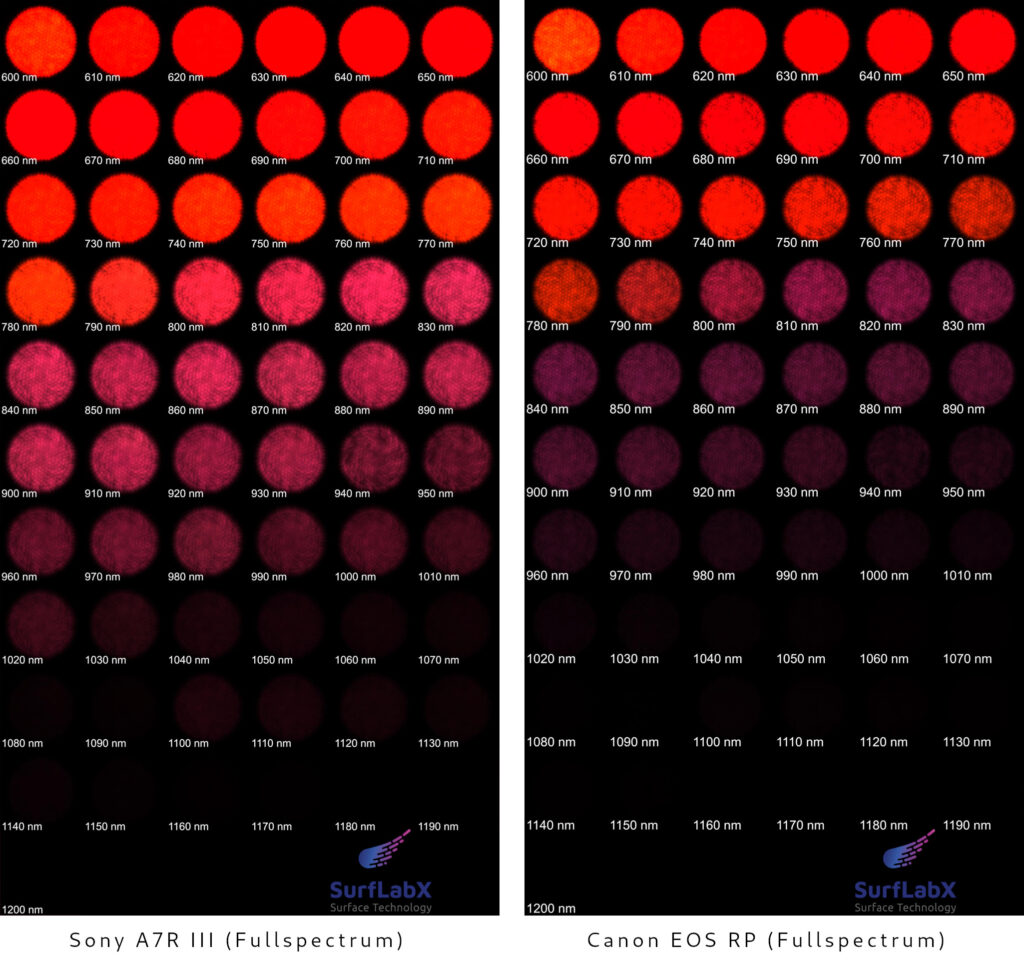
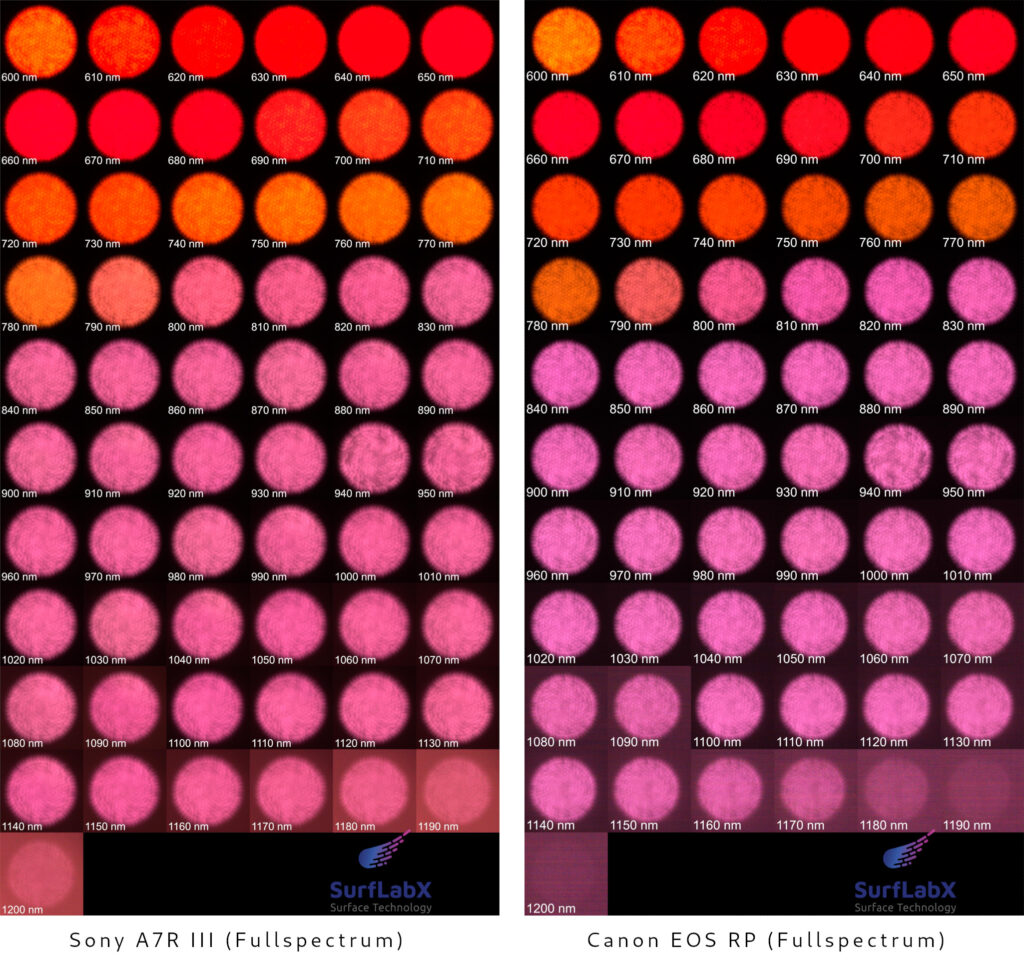
Although differences in the higher wavelengths are recognizable in both the unprocessed version and the brightened version of the test series, both cameras basically produce results that do not differ that much in practice. At the higher wavelengths, both cameras produce noise, but the light beam still remains visible.
Die Ergebnisse der anderen Kameras siedeln sich alle irgendwo dazwischen an, tendenziell näher an den Ergebnissen der Sony. In dieser Testreihe sind keine gestackten Sensoren enthalten, ebenfalls wäre ein Vergleich eines Monochrom Sensors interessant. Vielleicht ergibt sich in Zukunft die Möglichkeit dies noch einmal zu messen. Bis dahin möchte ich den Kreis wieder schließen zu meinem ursprünglichen Bauchgefühl: “Es macht eigentlich keinen großen Unterschied”.
Once again, I would like to thank the company SurfLabX, especially Mr. Karpen, for providing the measurement results and for the interesting exchange about camera technology.
